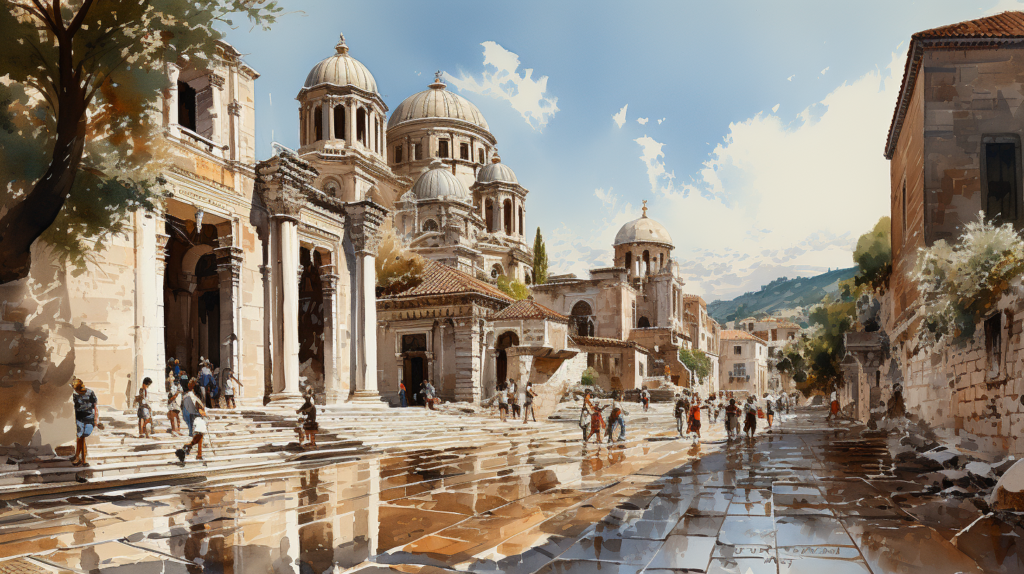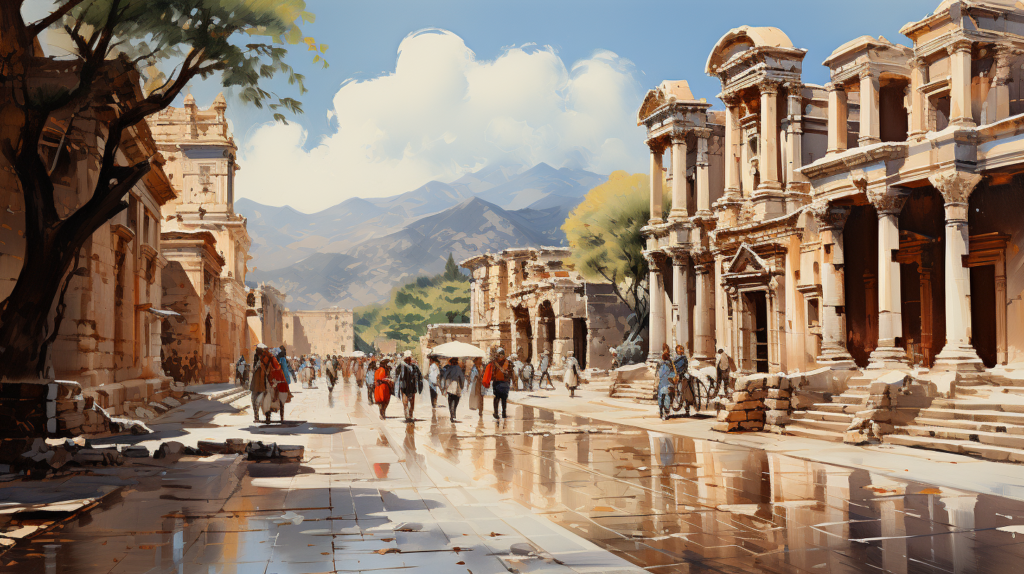Unveiling the Magnificence of the Temple of Artemis – Captivating Architecture from Ancient Times
The Temple of Artemis, a symbol of ancient grandeur, shows us the amazing beauty of the past. Its towering pillars and detailed designs take us back to a time of skilled craftsmanship and timeless beauty. This special temple was dedicated to Artemis, the Greek goddess of hunting and nature. It was an important place for culture and religion in the ancient city of Ephesus.
Travel back to the 6th century BCE and see the amazing Temple of Artemis. This engineering marvel had over a hundred tall columns and a fancy altar with detailed carvings. The temple was huge, about 377 feet long and 180 feet wide. Its fancy roof showed off the riches of the Ephesian society.
The Temple of Artemis was not only a religious place but also a symbol of the city’s riches, influence, and strong dedication to their goddess. Despite facing destruction and rebuilding many times in the past, it triumphed over the difficulties. One notable event was in 356 BCE when a man named Herostratus foolishly set it on fire to gain fame, but its importance could not be erased.
Today, there’s only one column left, standing tall and proud. It reminds us of how magnificent ancient Ephesus used to be. Even though the temple isn’t fully intact anymore, its legacy lives on. It fascinates historians, archaeologists, and travelers. Come with us as we explore the captivating story of the Temple of Artemis. It’s an amazing architectural masterpiece that still inspires awe and admiration.

Unearthing the Mysteries of Wonder – Discovering the Ancient Site’s Lasting Legacy
The Temple of Artemis is a captivating place that has fascinated people throughout history. Its stories of worship, grandeur, and human dreams are woven into its rich tapestry. As we explore the past, we uncover the many layers that make up its lasting legacy.
In ancient times, Ephesus was a busy place. It was located on the coast of modern Turkey. People came there for trade, religion, and learning. The temple dedicated to Artemis, the goddess of nature and animals, was magnificent. It showed how rich and powerful the city was. The temple had tall marble columns and a beautiful altar. Ephesus was impressive and important.
Even though it was destroyed in 356 BCE by Herostratus, a man who wanted to be famous, the Temple of Artemis remained glorious. It became a symbol of strength as the city rebuilt it each time, making it even more impressive. Like the phoenix, the temple seemed to rise from its own ashes, showing the city’s unstoppable spirit.
Today, there is a single column that remains as evidence of what used to be – a symbol of a city’s strength, a guiding light for its goddess, and an incredible building that still inspires. The Temple of Artemis, even though it’s now just ruins, offers a glimpse into the past, allowing us to imagine how vibrant ancient Ephesus once was.
The Temple of Artemis was a remarkable architectural achievement. It had great importance in society and showed incredible strength in difficult times. It still fascinates historians, archaeologists, and visitors, telling a captivating story of wonder. Even in ruins, the temple stands as a symbol of ancient civilization’s greatness, telling stories of human creativity, cultural dedication, and historical strength.
As we explore the secrets of this amazing building, we are reminded that things people make don’t last forever. The Temple of Artemis used to be a symbol of beauty and power, but now it’s a reminder of how things change over time. Even so, its impact continues, spreading through history and reminding us of the amazing things people can do.

Appreciating the Processionals and Courtyards – The Festival Celebrations and Rituals
The processions and courtyards of the Temple of Artemis were really important parts of its religious and social significance. They weren’t just physical features of the temple, but they made the temple come alive with all its activities and vibrant life.
The processions were fancy events, often held during festivals and important religious occasions. These were big shows that attracted lots of people, not just from Ephesus but also from far away. The participants would walk through the city and end at the temple, carrying the statue of Artemis on a bed as the main part of the procession. It showed the goddess’s presence everywhere and her connection with her loyal followers. The procession was basically a mix of religious devotion, community involvement, and exciting celebration that showed what life was like back then.
The courtyards of the Temple of Artemis were a big open space where people gathered for events. They were the center of the temple, where daily life and community interactions happened. On festival days, the courtyards were busy and filled with energy and excitement. They had altars, statues, and writings that made them even more special and important.
By studying these places and the rituals performed there, we can get a glimpse into the social structure of the time. The courtyards acted as stages where power, social hierarchies, and community values were showcased. On the other hand, the procession was a way to publicly demonstrate religious devotion and unity within the community.
Also, the processions and rituals in the courtyard were not just religious events but also important social gatherings. They brought people together, strengthening bonds and shared values. They were places for socializing, making deals, and even politics. They were spaces where the sacred and everyday life came together, where people worshipped and interacted.
To sum up, understanding the processions and courtyards of the Temple of Artemis means knowing their many roles. They were more than just physical spaces; they were the lifeblood of the temple, pulsing with religious, social, and cultural energy. Studying them helps us dive deeper into the complex web of ancient Ephesian society, unraveling how religion, culture, and community all intertwined. As we keep exploring, the Temple of Artemis reveals itself not only as an amazing building, but as a lively place that reflected the society of its time.

Exploring the Guarded Treasures – Mythical Statues, Stunning Paintings, and Priceless Artifacts
The Temple of Artemis was an important ancient site. It had beautiful statues that showed the skill of the artists. Each statue had a story that was part of Ephesian society.
The beautiful paintings on the temple walls are fascinating. They show everyday life, religious rituals, and stories from myths. These paintings give us a peek into the lives, beliefs, and traditions of ancient Ephesians. The paintings were very detailed and show how sophisticated the ancient Ephesian art was.
No exploration of the temple is finished without talking about the valuable objects. They range from fancy paintings to pretty jewelry and give us a real connection to the past. They tell us about how people made art and how society worked in Ephesus. These treasures are kept safe and help us understand a civilization that’s gone but still interesting.
Simply put, the mythical statues, beautiful paintings, and priceless artifacts of the Temple of Artemis are not just for decoration. They tell stories, show us about culture, and teach us about history. They make the temple even more special, going beyond just being an amazing building. They let us learn more about society, culture, and history. Through these treasures, the Temple of Artemis keeps revealing its secrets, fascinating historians, archaeologists, and art lovers.

Connecting with Nature through Rituals and Festivals – Worship in a Sacred Place
The Temple of Artemis had beautiful surroundings and was a perfect place for the Ephesians to connect with nature. They had rituals and festivals there, which were not just about being religious, but also about bringing the community together and keeping society in order.
One special event was the yearly celebration of the Ephesia. It was a big festival dedicated to Artemis. The city would be full of sacred parades, ceremonial music, and people wearing festive clothes. People from Ephesus and other places would gather at the temple and bring fruits, grains, and other gifts to show thanks to Artemis. She was the goddess of fertility and hunting and gave them many good things
The Ephesia also had plays that showed stories from myths. These plays helped teach their culture and values. They happened in open spaces, so nature was like a big stage. The Ephesians didn’t just watch nature, they were part of it. The rituals made nature and society mix together.
In Ephesian worship, there was a special gathering called the Panegyris. It was a place where people worshipped and traded. At the temple’s sacred grove, there were stalls with all kinds of things to buy. They had local food and really nice things to buy. This event was important for both religion and the economy, showing how nature, society, and the divine are all connected.
The rituals and festivals at the Temple of Artemis were important to the people of Ephesus. They helped them feel connected to nature in both physical and spiritual ways. These events were a big part of Ephesian culture. They combined religious worship, socializing, and making money with the natural world. The Ephesians didn’t just live in nature; they celebrated it and understood their place in it. The Temple of Artemis wasn’t just a place of worship. It was a special place where people and nature came together.
Uncovering Historical Events – Legends, People, and Places Connected to the Temple
The Temple of Artemis was an important part of Ephesian culture. It connected humans, gods, and nature. It wasn’t just a beautiful building or a place to worship. It represented the values and traditions of the Ephesians. The temple was a special place where people found comfort, met others, and did business. The stories, people, and locations connected to the temple help us learn about ancient societies.
The Temple of Artemis was an impressive and important structure. Although we can only learn about its grandeur from historical records and remains, its impact is still felt today. Historians, archaeologists, and enthusiasts are fascinated by its cultural and historical significance. The temple encourages us to reconsider our connection with nature and inspires us to work towards restoring the balance it represented in the past.
The Temple of Artemis shows how people have always wanted to connect with the gods, nature, and each other. Its lessons still matter today, just like they did long ago. When we learn about its interesting past, we also learn about the people of Ephesus and what it means to be human.
Deeper Reading:
- “Seven Wonders of the Ancient World” by Peter A. Clayton. This book offers a broader perspective on the Seven Wonders of the Ancient World, with a detailed chapter dedicated to the Temple of Artemis. Peter A. Clayton provides a concise yet informative overview of the temple’s history and significance, making it a great choice for those seeking a general understanding of this ancient wonder.
- “Seven Wonders of the Ancient World” by Paul Jordan. A well-written and visually engaging book that takes readers on a captivating journey through the seven wonders of the ancient world, including the Temple of Artemis at Ephesus. The book provides a comprehensive overview of each wonder, exploring their historical significance, construction, and cultural impact. Paul Jordan’s storytelling style makes the ancient wonders come to life, allowing readers to immerse themselves in the fascinating history and mysteries surrounding these architectural marvels.
